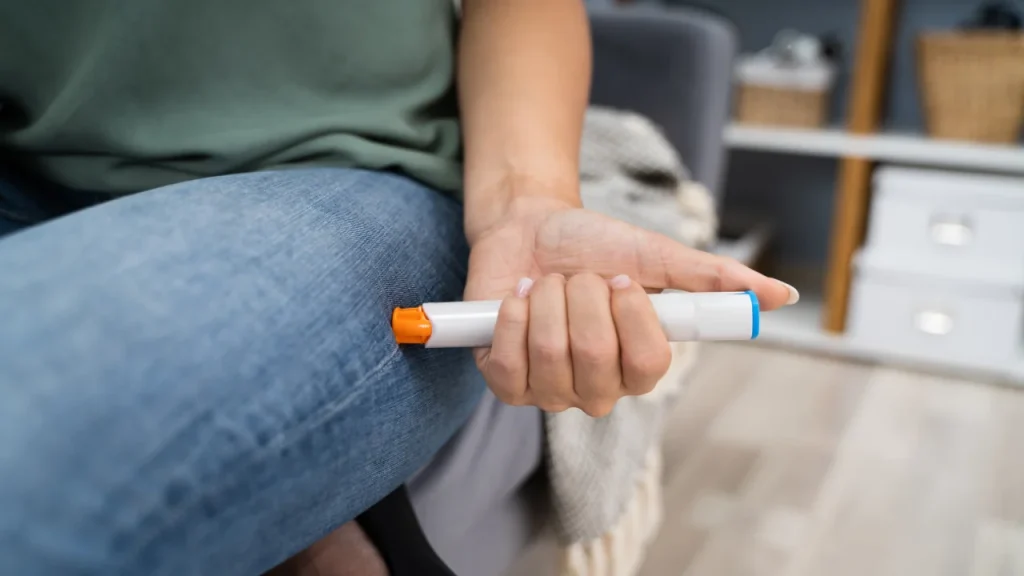Training and Assessment Delivered on Behalf of Allens Training Pty Ltd RTO 90909
How Can I Get an EpiPen for My First Aid Kit?
We all know that EpiPens save lives during severe allergic reactions. But when it comes to buying one for your school, business, or personal first aid kit, the decision isn’t always straightforward. Is it necessary? Is it worth the cost? How do you even get one?
In this article, we’ll explore everything you need to know about adding an EpiPen to your first aid arsenal. We’ll cover:
- What anaphylaxis is and how an EpiPen works
- How to get an EpiPen (with or without a prescription)
- The costs involved
- Proper storage and maintenance
- Why you might need one even if you don’t have allergies
- Training options to use an EpiPen effectively
Let’s dive in and demystify the world of EpiPens.
Anaphylaxis and EpiPens: A Life-Saving Duo
Imagine your immune system as an overzealous security guard. Usually, it does a great job protecting you from harm. But during anaphylaxis, it goes haywire, like a guard who suddenly can’t tell the difference between a harmless visitor and a dangerous intruder. It starts attacking everything, including your own body.

This is anaphylaxis – a severe, potentially life-threatening allergic reaction that can strike quickly. Common triggers include certain foods, insect stings, medications, and latex. Your body essentially declares war on itself, causing symptoms that can rapidly become life-threatening.
Enter the EpiPen – think of it as the cool-headed supervisor that steps in to calm down our overzealous security guard. It delivers a dose of adrenaline, essentially hitting the ‘reset’ button on your immune system. It’s not a cure, but it buys crucial time to get medical help, potentially saving a life in the process.
Getting Your Hands on an EpiPen
Now, onto the main event – how to actually get an EpiPen for your first aid kit. There are a few ways to go about this, depending on your situation.
Option 1: The Prescription Route
If you or someone in your family has been diagnosed with severe allergies, this is your best bet. Here’s why:
- It’s cheaper. With a prescription, you can get an EpiPen at a subsidised price through the Pharmaceutical Benefits Scheme (PBS).
- It’s personalised. Your doctor can advise on the right dosage and provide specific instructions for your situation.

Option 2: Over-the-Counter Purchase
Don’t have a prescription? No worries. You can still get an EpiPen, but it’ll cost you a bit more.
Yes, both adrenaline injector devices can be purchased at full price (not PBS subsidised) without a prescription from pharmacies. This is great news for those wanting to be prepared, even without a diagnosed allergy.
You can pop into your local pharmacy or even order online from reputable online pharmacies. Just be prepared to pay full price – it’s not cheap, but can you really put a price on peace of mind?
Pharmacy vs Online: Which is Better?
Both have their pros and cons. Let’s break it down:
Local Pharmacy:
Pros: Immediate availability, face-to-face advice from a pharmacist.
Cons: Might be more expensive, limited stock.
Online Pharmacy:
Pros: Often cheaper, can compare prices easily.
Cons: Delivery time, need to be careful about expiry dates.
Speaking of expiry dates…
The Ticking Clock: EpiPen Shelf Life
EpiPens typically have a shelf life of about 12 to 18 months from the date of manufacture. Here are some key points to keep in mind:
- Expiration Date: Always check the expiration date on the EpiPen packaging. The expiration date is usually printed on both the box and the pen itself.
- Online Purchases: Be cautious when buying online. Sometimes you can snag a bargain, but the trade-off might be a shorter shelf life. It’s not uncommon to receive an EpiPen with only 6 months left before expiry.
- Replacement: Mark the expiration date in your calendar and set a reminder to replace it. An expired EpiPen is about as useful as a chocolate teapot in an emergency.

Storing Your EpiPen: Keep It Cool, But Not Too Cool
Proper storage is crucial to ensure your EpiPen remains effective for its full shelf life. Here’s what you need to know:
- Temperature: Store it at room temperature, ideally between 15°C and 25°C. Avoid exposing it to extreme temperatures.
- Location: Some people keep it in their first aid kit, which can be insulated and cooler. Others prefer to store it in an office first aid cabinet that’s out of the weather.
- On the Go: If your job keeps you on the road, it’s a good idea to keep one handy in your vehicle. Just make sure it’s not exposed to extreme heat or cold.
- Visibility: Wherever you choose to store it, make sure it’s easily accessible and that everyone knows where it is.

The Anaphylaxis Action Plan: Your Emergency Roadmap
Having an EpiPen is great, but knowing when and how to use it is even better. That’s where an Anaphylaxis Action Plan comes in handy.
This plan outlines the steps to take in case of a severe allergic reaction. It includes information like:
- Signs and symptoms of anaphylaxis
- When to use the EpiPen
- How to use the EpiPen
- What to do after using the EpiPen
- Emergency contact numbers
Even if you don’t have a diagnosed allergy, having a general action plan in your first aid kit can be a lifesaver. It’s like having a cheat sheet for emergencies. When storing your EpiPen, remember to keep the Anaphylaxis Action Plan with it. Here’s why:
- Quick Reference: In an emergency, every second counts. Having the action plan right there means no time wasted searching for information.
- Clear Instructions: Even if you’ve had training, stress can make you forget. The action plan provides clear, step-by-step instructions.
- Information for Others: If you’re not around, the action plan gives others the information they need to respond effectively.
Consider laminating the action plan and attaching it to your EpiPen case or first aid kit. This way, it’s protected and always on hand when needed.
But I Don’t Have Allergies – Do I Really Need This for the Workplace?
You might be thinking, “We don’t have anyone with known allergies in our workplace. Do we really need an EpiPen?”
While it’s not a legal requirement for all workplaces, having an EpiPen on hand can be a game-changer in certain industries. Think about it:
- Restaurants: With food allergies on the rise, having an EpiPen could save a customer’s life if they accidentally consume an allergen.
- Shopping Centres: With thousands of people passing through daily, the chances of encountering someone with a severe allergy are higher.
- Schools: Children are more likely to have unknown allergies, and accidents can happen during lunch or snack time.
- Outdoor Work Sites: Bee stings are a common cause of anaphylaxis. For workers in construction, landscaping, or other outdoor industries, an EpiPen could be a lifesaver.
Remember, allergic reactions can happen to anyone, anytime – even if they’ve never had one before. It’s about being prepared for the unexpected.

The Cost Factor: Breaking It Down
Let’s talk dollars and cents. The cost of an EpiPen can vary significantly depending on how you obtain it:
- With a PBS Prescription: If you have a diagnosed allergy, you can get an EpiPen for as little as $30 through the Pharmaceutical Benefits Scheme.
- Private Prescription: If you don’t qualify for PBS but have a prescription, expect to pay between $70 to $100.
- Over-the-Counter: Without any prescription, an EpiPen can cost $100 or more.
Yes, it’s an investment. But consider this: what’s the cost of not having one when you need it? In an emergency, that $100 could be the best money you’ve ever spent.
Get Hands-On with HLTAID011 Provide First Aid
Want to feel truly confident about using an EpiPen? Our HLTAID011 Provide First Aid course has got you covered. This comprehensive course doesn’t just teach you about EpiPens – it gives you hands-on practice.
You’ll learn: How to recognize the signs of anaphylaxis. When and how to use an EpiPen correctly. What to do before and after administering adrenaline
Plus, you’ll get to practice with training devices, so you’ll know exactly what to expect in a real emergency. Our experienced trainers make learning engaging and ensure you leave feeling confident in your skills. Remember, in an emergency, you don’t rise to the occasion – you fall back on your training.
The Bottom Line: Better Safe Than Sorry
At the end of the day, adding an EpiPen to your first aid kit is a personal decision. But the peace of mind knowing you’re prepared for a severe allergic reaction – whether it’s you, a family member, or a complete stranger – is priceless. So, why not take that extra step in your first aid preparedness?
If you’re keen to level up your first aid game even further, why not check out our first aid courses? We’ll teach you everything from basic wound care to how to use that EpiPen like a pro.


